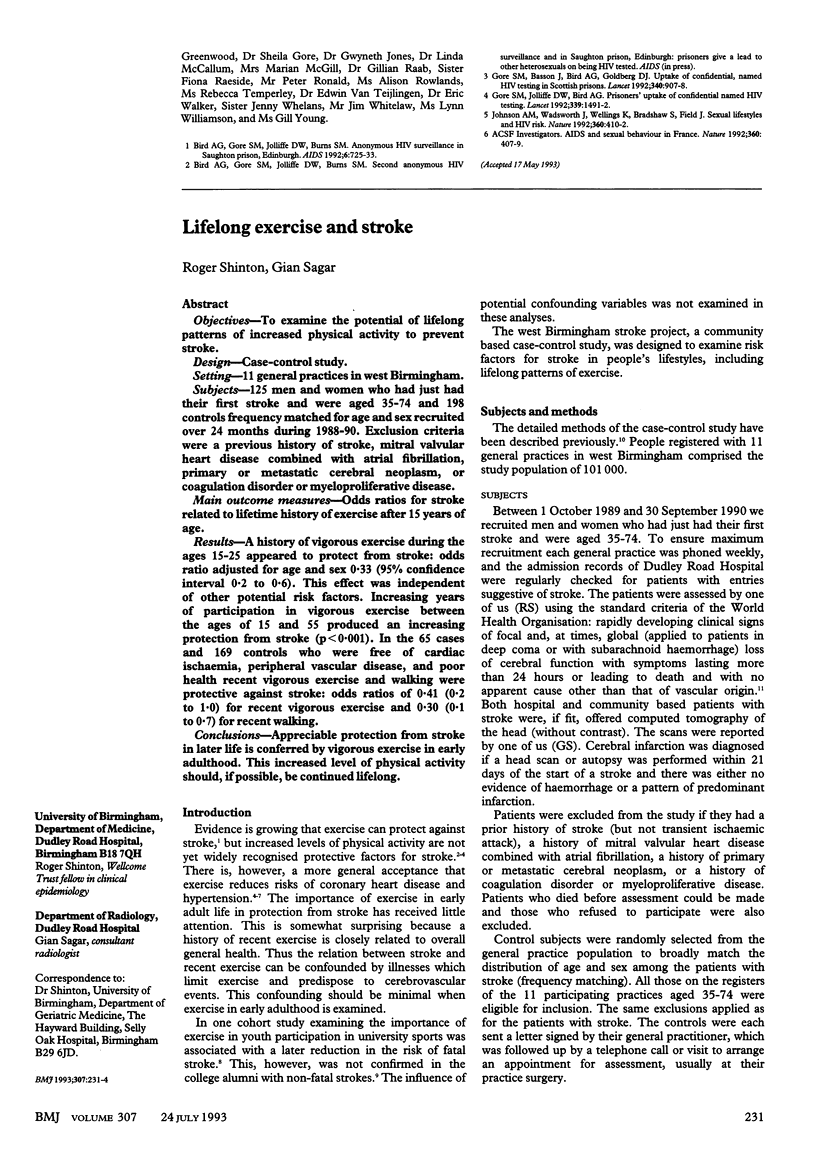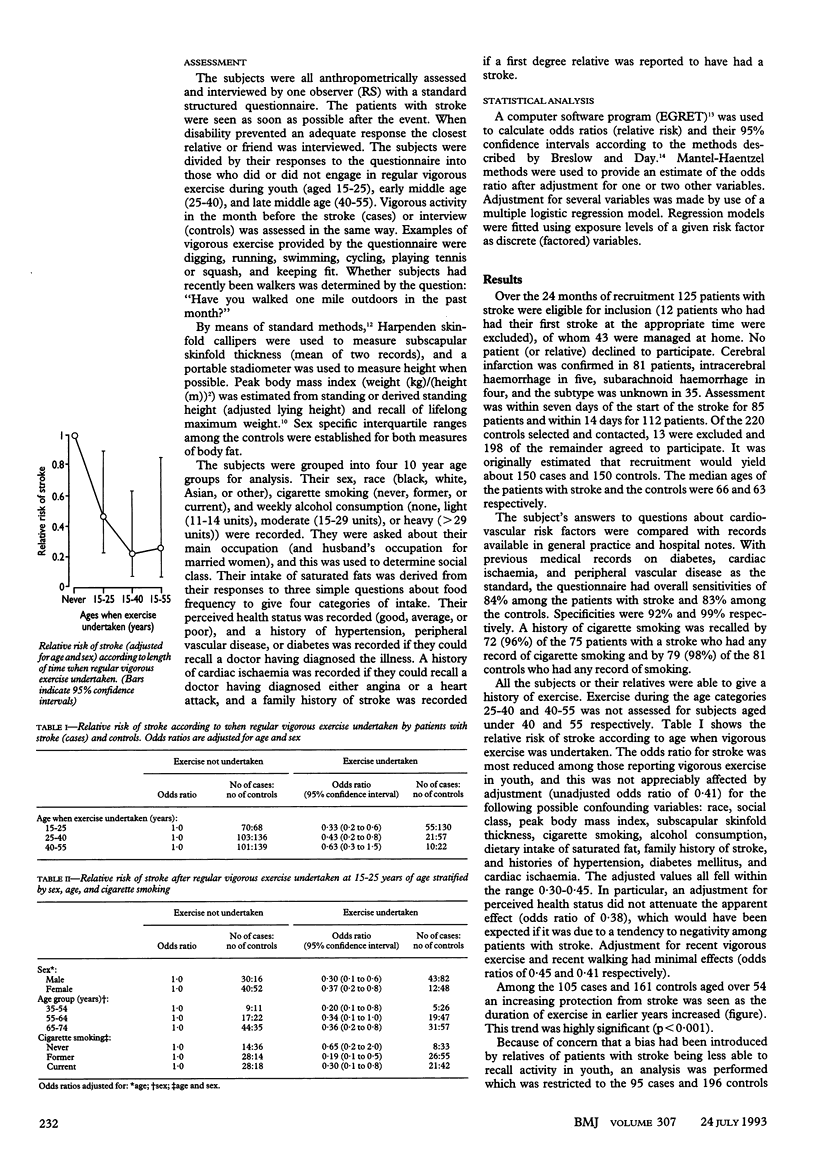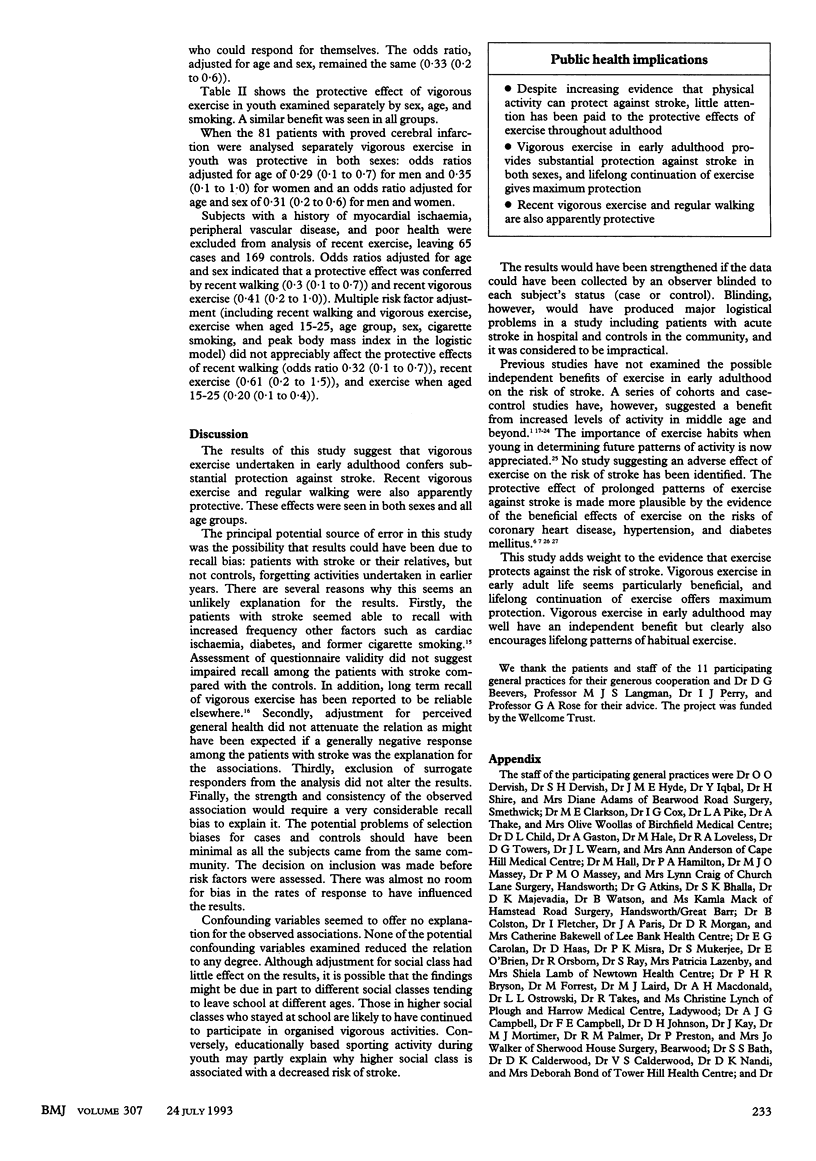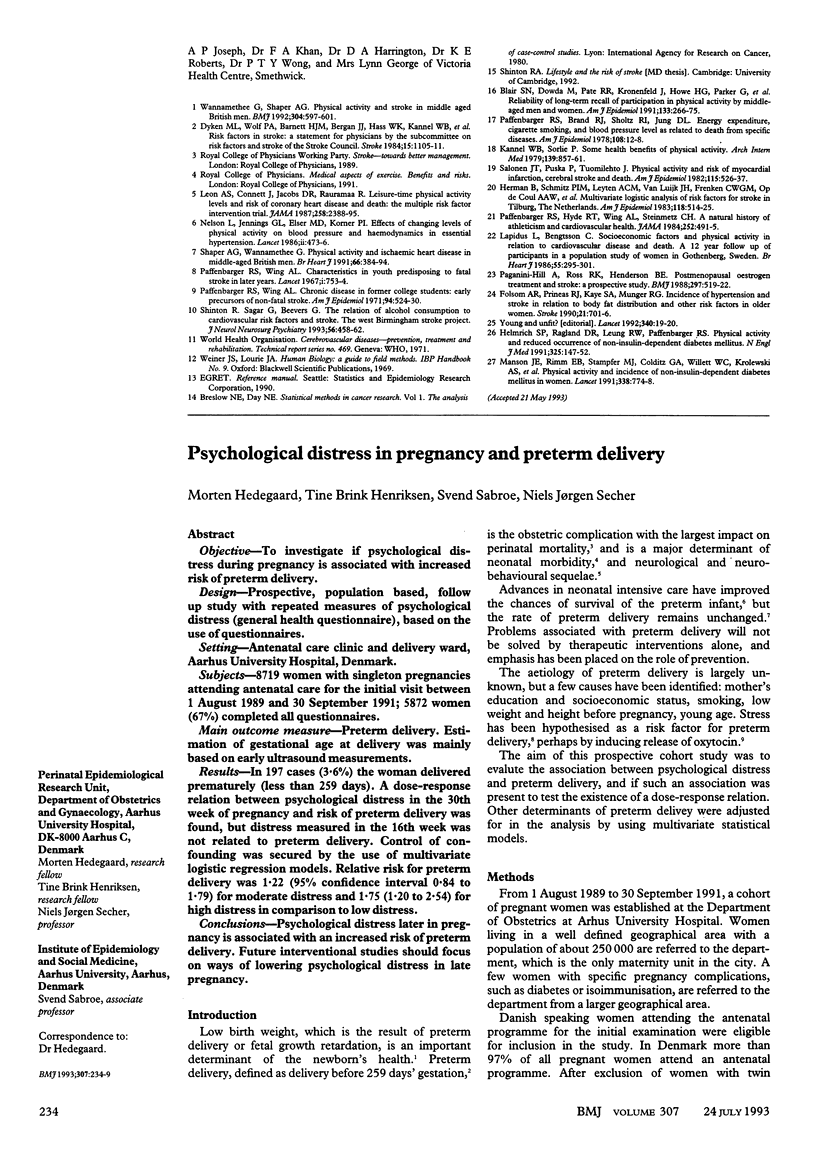Abstract
OBJECTIVES--To examine the potential of lifelong patterns of increased physical activity to prevent stroke. DESIGN--Case-control study. SETTING--11 general practices in west Birmingham. SUBJECTS--125 men and women who had just had their first stroke and were aged 35-74 and 198 controls frequency matched for age and sex recruited over 24 months during 1988-90. Exclusion criteria were a previous history of stroke, mitral valvular heart disease combined with atrial fibrillation, primary or metastatic cerebral neoplasm, or coagulation disorder or myeloproliferative disease. MAIN OUTCOME MEASURES--Odds ratios for stroke related to lifetime history of exercise after 15 years of age. RESULTS--A history of vigorous exercise during the ages 15-25 appeared to protect from stroke: odds ratio adjusted for age and sex 0.33 (95% confidence interval 0.2 to 0.6). This effect was independent of other potential risk factors. Increasing years of participation in vigorous exercise between the ages of 15 and 55 produced an increasing protection from stroke (p < 0.001). In the 65 cases and 169 controls who were free of cardiac ischaemia, peripheral vascular disease, and poor health recent vigorous exercise and walking were protective against stroke: odds ratios of 0.41 (0.2 to 1.0) for recent vigorous exercise and 0.30 (0.1 to 0.7) for recent walking. CONCLUSIONS--Appreciable protection from stroke in later life is conferred by vigorous exercise in early adulthood. This increased level of physical activity should, if possible, be continued lifelong.
Full text
PDF



Selected References
These references are in PubMed. This may not be the complete list of references from this article.
- Blair S. N., Dowda M., Pate R. R., Kronenfeld J., Howe H. G., Jr, Parker G., Blair A., Fridinger F. Reliability of long-term recall of participation in physical activity by middle-aged men and women. Am J Epidemiol. 1991 Feb 1;133(3):266–275. doi: 10.1093/oxfordjournals.aje.a115871. [DOI] [PubMed] [Google Scholar]
- Folsom A. R., Prineas R. J., Kaye S. A., Munger R. G. Incidence of hypertension and stroke in relation to body fat distribution and other risk factors in older women. Stroke. 1990 May;21(5):701–706. doi: 10.1161/01.str.21.5.701. [DOI] [PubMed] [Google Scholar]
- Helmrich S. P., Ragland D. R., Leung R. W., Paffenbarger R. S., Jr Physical activity and reduced occurrence of non-insulin-dependent diabetes mellitus. N Engl J Med. 1991 Jul 18;325(3):147–152. doi: 10.1056/NEJM199107183250302. [DOI] [PubMed] [Google Scholar]
- Herman B., Schmitz P. I., Leyten A. C., Van Luijk J. H., Frenken C. W., Op De Coul A. A., Schulte B. P. Multivariate logistic analysis of risk factors for stroke in Tilburg, The Netherlands. Am J Epidemiol. 1983 Oct;118(4):514–525. doi: 10.1093/oxfordjournals.aje.a113657. [DOI] [PubMed] [Google Scholar]
- Kannel W. B., Sorlie P. Some health benefits of physical activity. The Framingham Study. Arch Intern Med. 1979 Aug;139(8):857–861. [PubMed] [Google Scholar]
- Lapidus L., Bengtsson C. Socioeconomic factors and physical activity in relation to cardiovascular disease and death. A 12 year follow up of participants in a population study of women in Gothenburg, Sweden. Br Heart J. 1986 Mar;55(3):295–301. doi: 10.1136/hrt.55.3.295. [DOI] [PMC free article] [PubMed] [Google Scholar]
- Leon A. S., Connett J., Jacobs D. R., Jr, Rauramaa R. Leisure-time physical activity levels and risk of coronary heart disease and death. The Multiple Risk Factor Intervention Trial. JAMA. 1987 Nov 6;258(17):2388–2395. [PubMed] [Google Scholar]
- Manson J. E., Rimm E. B., Stampfer M. J., Colditz G. A., Willett W. C., Krolewski A. S., Rosner B., Hennekens C. H., Speizer F. E. Physical activity and incidence of non-insulin-dependent diabetes mellitus in women. Lancet. 1991 Sep 28;338(8770):774–778. doi: 10.1016/0140-6736(91)90664-b. [DOI] [PubMed] [Google Scholar]
- Nelson L., Jennings G. L., Esler M. D., Korner P. I. Effect of changing levels of physical activity on blood-pressure and haemodynamics in essential hypertension. Lancet. 1986 Aug 30;2(8505):473–476. doi: 10.1016/s0140-6736(86)90354-5. [DOI] [PubMed] [Google Scholar]
- Paffenbarger R. S., Jr, Brand R. J., Sholtz R. I., Jung D. L. Energy expenditure, cigarette smoking, and blood pressure level as related to death from specific diseases. Am J Epidemiol. 1978 Jul;108(1):12–18. [PubMed] [Google Scholar]
- Paffenbarger R. S., Jr, Hyde R. T., Wing A. L., Steinmetz C. H. A natural history of athleticism and cardiovascular health. JAMA. 1984 Jul 27;252(4):491–495. [PubMed] [Google Scholar]
- Paffenbarger R. S., Jr, Wing A. L. Characteristics in youth predisposing to fatal stroke in later years. Lancet. 1967 Apr 8;1(7493):753–754. doi: 10.1016/s0140-6736(67)91367-0. [DOI] [PubMed] [Google Scholar]
- Paffenbarger R. S., Jr, Wing A. L. Chronic disease in former college students. XI. Early precursors of nonfatal stroke. Am J Epidemiol. 1971 Dec;94(6):524–530. doi: 10.1093/oxfordjournals.aje.a121351. [DOI] [PubMed] [Google Scholar]
- Paganini-Hill A., Ross R. K., Henderson B. E. Postmenopausal oestrogen treatment and stroke: a prospective study. BMJ. 1988 Aug 20;297(6647):519–522. doi: 10.1136/bmj.297.6647.519. [DOI] [PMC free article] [PubMed] [Google Scholar]
- Salonen J. T., Puska P., Tuomilehto J. Physical activity and risk of myocardial infarction, cerebral stroke and death: a longitudinal study in Eastern Finland. Am J Epidemiol. 1982 Apr;115(4):526–537. doi: 10.1093/oxfordjournals.aje.a113334. [DOI] [PubMed] [Google Scholar]
- Shaper A. G., Wannamethee G., Weatherall R. Physical activity and ischaemic heart disease in middle-aged British men. Br Heart J. 1991 Nov;66(5):384–394. doi: 10.1136/hrt.66.5.384. [DOI] [PMC free article] [PubMed] [Google Scholar]
- Wannamethee G., Shaper A. G. Physical activity and stroke in British middle aged men. BMJ. 1992 Mar 7;304(6827):597–601. doi: 10.1136/bmj.304.6827.597. [DOI] [PMC free article] [PubMed] [Google Scholar]


